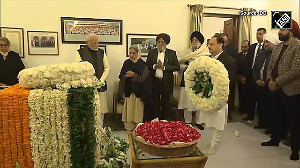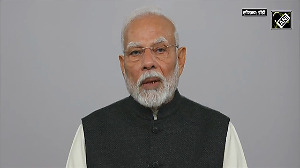The integration of national carriers Air India and Indian Airlines, which were merged in 2007, has hit a major roadblock with regard to the setting up of a common reservation platform for inventory sales.
This will delay the completion of the merger process by at least another 12-15 months.
Raghu Menon, CMD of National Aviation Company of India, had said last year that more than 70 per cent of the merger process would be completed by the end of FY09.
The carriers currently have distinct platforms powered by IT service providers Unisys (Air India) and IBM (Indian Airlines).
Getting onto a common platform is one of the key requirements for integration which would give them a common airline code -- AI, apart from an effective management of inventory and network planning.
Last year, Nacil had floated a tender for an IT service provider and the shortlisted companies included -- EDS and Amadeus. Of the two, EDS had been chosen as the lowest bidder.
According to sources in the company, EDS has now gone back to Nacil and asked for the contract period (the period within which the new system needs to be set up) to be extended to 15 months, while the tender specified the period as 9 months from the award of the contract.
"If this is agreed to, the period for setting it will be extended by more than a year. The only other alternative is going for another bidding process, which will mean a lot of delay," said a source close to the development.
The source also said that the services to be provided by the shortlisted bidder is also not commensurate with the standards of Star Alliance, the global airline alliance which Air India has recently joined.
"This means that we will not be able to use the benefits of the alliance even though we are already paying membership fee, because we have not a common sales platform.
"Also, even after the system is set up, the alliance has several ways of verifying its efficiency which will delay the membership by another one-and-a-half to two years," said an Air India executive.
Star Alliance has 24 member airlines and offers more than 16,500 daily flights to 912 destinations in 159 countries. Getting a membership would give the airline several benefits in terms of network and code sharing, and immense cost cutting opportunities through a worldwide sales platform and common purchase benefits.
Prior to its entry into the Star alliance, AI is required to comply with the minimum joining requirements stipulated by the Alliance, one of which is merging the sales platform.
Meanwhile, the executive said that staff integration continues to be a problem for merger.
Air India currently has a total employee strength of 31,500, while its fleetsize is 151. This brings the employee to aircraft ratio to 209:1. In comparison, Jet Airways has ratio of 165:1.
The company structure has been divided into strategic business units, which include domestic and international services, cargo business, ground handling business, maintenance, repair and overhaul (MRO), low-cost carriers and other allied activities.
"Our HR integration, which is happening from top down, has been done only till the executive director level. The integration process for general managers is still on," said the executive.
Overstaffing comes from the fact that the airliner carries out several functions such as security and catering in-house, while these are usually outsourced by other companies.
For instance, Jet has around 4,000 employees on contract. Taking this into account, the employee to aircraft ratio for Jet would be 211:1. Interestingly, if these extra departments were to be excluded from the Nacil payrolls, it would leave the organisation understaffed, even as it would bring the aircraft to employee ratio down to a large extent.
"A PSU cannot work the same way in which a private company does. You also have to take into account that many of these functions earn us revenues. For instance, our groundhandling unit would earn revenues of Rs 800 crore," said an AI spokesperson.







 © 2024 Rediff.com -
© 2024 Rediff.com -